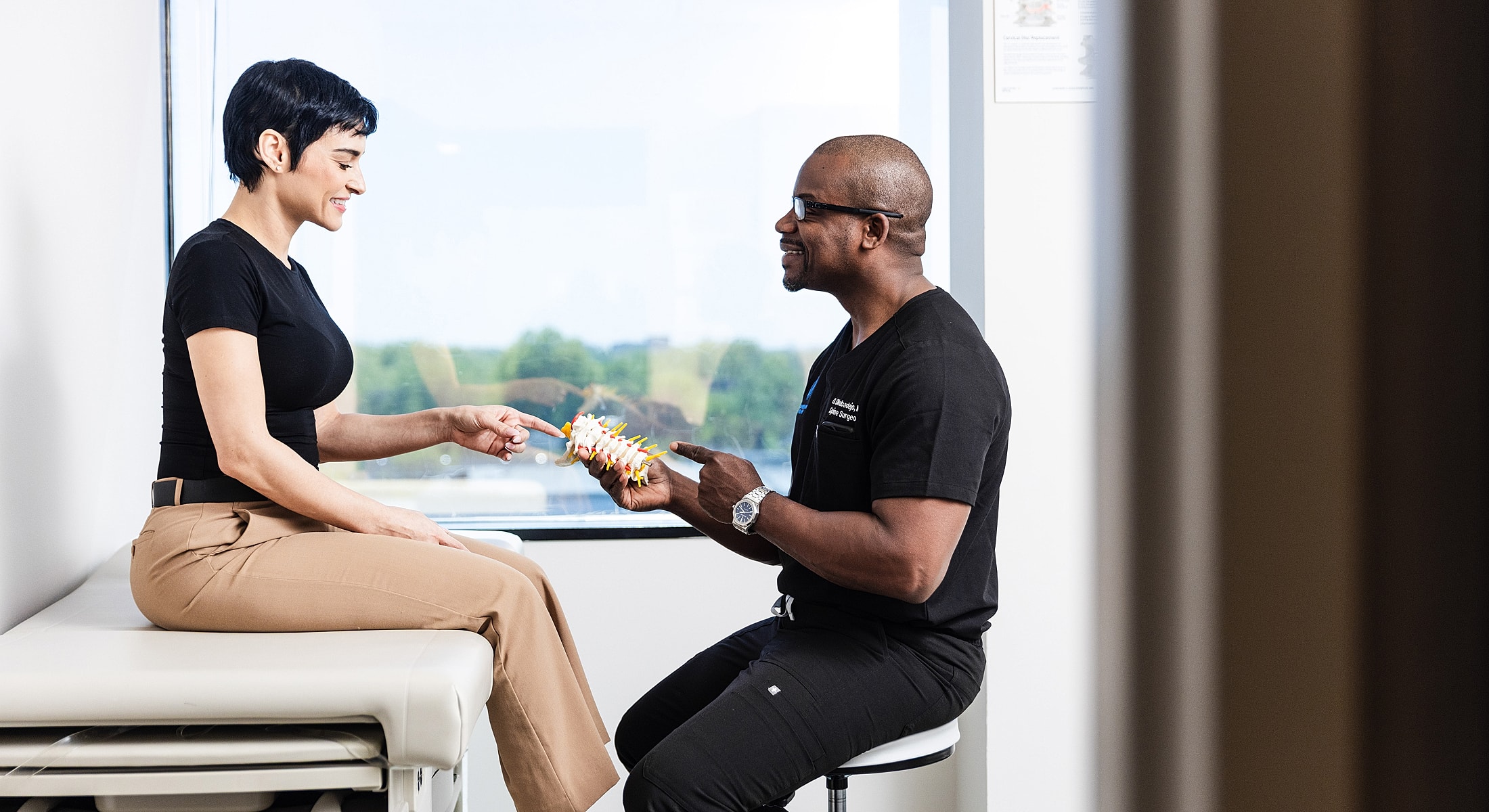
in New York & New Jersey

















When motion between vertebrae becomes painful—whether from disc degeneration, instability, trauma, or previous surgery—our NJ & NYC spinal fusion surgery may be the solution.
Spinal fusion surgery creates stability by joining two or more vertebrae together, often using implants, bone grafts, and surgical hardware.
At the Institute for Comprehensive Spine Care, we understand the complex nature of spinal health issues and the profound effect they can have on your quality of life. Led by renowned spine surgeon, Dr. Gbolahan Okubadejo, MD, FAAOS, we dedicate ourselves to an extensive range of surgical interventions, such as spinal fusion surgery, and customized care plans aimed at alleviating your discomfort and enhancing your mobility.
Spinal fusion surgery is a medical procedure designed to combine two or more vertebrae in your spine. This fusion process mimics the natural healing process of broken bones.
During the surgery, the chosen vertebrae are joined together using either bone grafts, metal rods, or screws. The aim of the surgery is to eliminate any painful movement between the vertebrae by making them into one solid bone. It's often used to correct issues such as spinal deformities, instability, or damage caused by diseases like arthritis or injuries. The approach depends on the affected area of the spine and your specific condition.

These options allow for customized care, whether you’re dealing with lower back instability, cervical spine narrowing, or another condition.
Spinal fusion is recommended when movement between vertebrae causes pain or when instability threatens spinal alignment or nerve health. Fusion may also be used after tumor removal or fracture repair to restore spinal integrity. Common conditions include:

If you’re experiencing chronic back pain, weakness, numbness, or difficulty walking due to a degenerative spinal condition, spinal deformity, instability, or injury that hasn’t improved with conservative treatments like physical therapy or medication, you might be a candidate.
However, your overall health also plays a significant role. Spinal fusion is a major surgery, and ideal candidates are generally those who are in good enough health to recover effectively. The specific nature of your spinal condition, your medical history, and your personal goals for treatment will all be considered when discussing whether spinal fusion surgery is the right option for you. If you are interested in finding out if you'd be a good candidate for spinal fusion surgery NYC & NJ spine surgeon, Dr. Gbolahan Okubadejo, can address that and answer any other questions you have during your initial consultation. Contact us today!

Each spine fusion technique uses a different approach to access the spine:
Procedures are performed under general anesthesia, often using advanced navigation or robotic systems to improve accuracy and outcomes.
Spinal fusion surgery can bring powerful relief, especially when instability is the root of the pain. Benefits include:
For the right patient, fusion can stop the cycle of recurrent symptoms and give the spine a chance to heal in a safe, supported position.
Recovery depends on the type of fusion and your overall health. Most patients stay in the hospital for 1-3 days. Early walking is encouraged, and you may need a brace for added support during the healing phase.
Return to light activity may take 4-6 weeks, with physical therapy beginning shortly after. Full recovery, including bone fusion, often takes 3-6 months, and Dr. Okubadejo will monitor progress with follow-up imaging and check-ins.
Every recovery is different. We’ll guide you through it at a pace that’s safe and sustainable for your body.
Fusion surgery is not about quick fixes—it’s about long-term spinal stability. When healing is complete, many patients report:
Fusion results depend on a combination of surgical success, patient health, and adherence to recovery plans—but for many, it’s the long-term answer they’ve been waiting for.

At The Institute for Comprehensive Spine Care, spinal fusion isn’t a default option, it’s a carefully chosen solution for the right situation. Dr. Gbolahan Okubadejo brings deep experience with complex spinal conditions and advanced fusion techniques, including robotic-assisted placement and minimally invasive approaches.
Spinal issues can dramatically impact your life, and we are committed to helping you regain control. Through meticulous diagnosis and tailored treatment, you will receive ongoing support and guidance to effectively manage your recovery journey. Working collaboratively, we will design a treatment plan that corresponds with your specific needs and goals. Dr. Okubadejo and his team will assist you in achieving your desired health outcome. You won’t be rushed, and you won’t be treated like a case number. With offices throughout New York and New Jersey, and a care team known for clear communication and lasting results, we’re here to help you move forward with stability and strength.
Symptoms can differ, but they often include persistent back or neck pain, instability or abnormal spinal motion, and weakness or numbness in the arms or legs.
Diagnosis typically involves a physical exam and a review of your medical history. Imaging tests like X-rays, CT scans, or MRIs may also be used to provide a detailed view of your spine and identify the underlying issues.
During the surgery, the affected vertebrae are fused together using a bone graft, screws, and rods. After surgery, you will need to stay in the hospital for a few days.
The recovery period can vary from a few weeks to several months, depending on the type of surgery and the individual patient's health condition. Physical therapy will typically be part of the recovery process.
Recovery times can vary based on the specific type of surgery and the patient's individual health status. Some people may return to normal activities within a few weeks, while others may require several months. Rehabilitation exercises and physical therapy are usually part of the recovery process.
Your surgeon will provide specific guidelines for your activity level during the recovery period. Initially, you may need to avoid activities that put stress on your spine. As you progress and heal, you will gradually be able to resume normal activities. It's important to follow your surgeon's instructions to ensure a successful recovery.
Preventing the need for spinal fusion surgery typically involves maintaining a healthy weight, practicing good posture, exercising regularly, and seeking timely treatment for back pain and other spinal conditions.


